
Home Institution: United Tribes Technical College
Major/Minor:
MRSEC Mentor: Ward
Investigation into tube formation with systematically lengthened molecular building blocks
The scope of our work is to investigate the host-guest interaction with monosulfonates. Our host molecules are compounds of Guanidinium monosulfonates; G[2-naphthlenesulfonate], G[4-biphenylsulfonate]. The Guanidinium monosulfonate compounds are saturated solutions in methanol. The guests o-xylene, 1,2-dichlorobenzene, and N,N-dimethylaniline are the added carefully to the saturated solutions. The crystals are then grown by methods of vapor diffusion and evaporation. Matthew J. Horner has already prepared crystals of G[monosulfonates] with ; benzene, toluene, o-xylene, m-xylene, p-xylene, mesitylene, ethylbenzene, anisole, 3,4-dimethylanisole, 3,5-dimethylanisole, N,N-dimethylanilene, 2-chlorotoluene, 1,2-dichlorobenzene, tertbutylbenzene, 1,2-dibromobenzene, 4-dimethylaminobenzonitrile, 4-dimethylaminobenzaldehyde, N,N-dimethyl-3-nitroaniline, N,N-dimethyl-p-nitroaniline, hexaflourobenzene, and guest free as well. These crystals were also grown by methods previously stated. We have the melting points on the majority of the crystals already grown. The rest of the crystals have yet to grow so we can use NMR to determine if the guest were included and single crystal x-ray crystallography will also be used to determine the crystal structure.
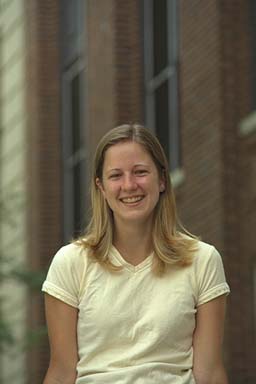
Home Institution: College of St Benedict
Major/Minor:
MRSEC Mentor: Bates
Partial Hydrogenation of Polybutadiene
Amphiphilic diblock copolymers that form bilayers in dilute solution can be modified to give them different physical properties. One process used to manipulate the polymer's properties is crosslinking. Through partial hydrogenation, the crosslinking density resulting can be controlled affecting physical abilities, such as stress and strain. Hydroxyl functional polybutadienes (PB-OH) were partially hydrogenated using decreasing amounts of a diimide produced by decomposing p-toluenesulfonylhydrazide (TSH). Tri-n-propylamine (TPA), an antioxidant, was used during hydrogenation to bind to the TDS fragments, hindering TDS from binding to the chain of the polymer. Using 1H NMR for analysis, the hydrogenated product contained excess TSH and its fragment, p-tolyl-p-toluenethiolsulfonate (TDS). The TSH and TDS finally were removed from the reaction solution by washing and extracting methods. The purified PB-OH can be used as a macroinitiator for the polymerization of polyethylene oxide (PEO) to form an amphiphilic diblock polymer. The diblock copolymers with varying amounts of saturation will be crosslinked in dilute aqueous solution and their properties analyzed using micromanipulation.
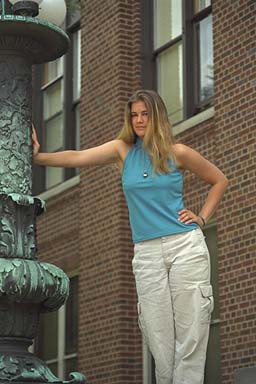
Home Institution: Penn State University
Major/Minor:
MRSEC Mentor: Ward
Isomer Separation with Guanidinium Disulfonate Apo-Crystals
The project I'm doing is investigating isomer separation with apo-crystals of guanidinium disulfonates. The separation is from selective inclusion of isomers into free spaces of apo-crystals to form stable molecular inclusion crystals, the shape and size of the free space in the apo-crystal structure are determined by pillar molecules. The biphenyl disulfonate and naphthalene groups are going to be used as pillars for separation of the xylene isomers and ethyl benzene. The apo-crystal of guanidinium biphenyl disulfonate (G2BPDS) and guanidinium naphthalene disulfonate (G2NDS) is added into a binary mixture of xylene isomers and ethyl benzene. The samples of disulfonates in the mixture solution are intermittently taken to estimate the inclusion rate of guest molecules into the apo-crystals. The crystals are analyzed with TGA and GC to measure mass and composition of inclusion guests in the crystals. Also, crystallization of guanidinium disulfonate in methanol solution will be used to separate tetramethylbenzene isomers.
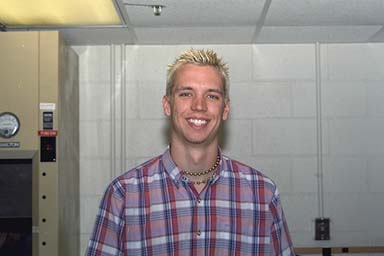
Home Institution: St Cloud State
Major/Minor:
MRSEC Mentor: Macosko
Characterization of the Co-continuity of Immiscible Polymer Blends
Blending immiscible polymers is an important method for preparing new materials. These blended materials can have superior properties than either polymer in the blend. The mixing of two homopolymers can create several different morphologies. Co-continuous blends have both polymer phases interpenetrating throughout the blend. My research goal is to detect and characterize this co-continuity. The blends that we are working with are composed of polyethylene oxide (PEO) and polystyrene (PS). The samples are prepared in a twins screw batch mixer. After blending the samples are pressed into disks and cooled. The methods we will use to detect co-continuity are scanning electron microscopy (SEM) with image analysis, rheology, and solvent extraction. SEM images can be examined using a computer program that calculates the amount of interface between phases. This interfacial length can be indicative of co-continuity. Rheological data can show how the mechanical properties of the blend vary with morphology. Solvent extraction is an experiment that is used to find the range of compositions for which a blend is co-continuous by selectively removing one polymer phase. These methods will be used in future experiments that examine the formation of co-continuous blends.
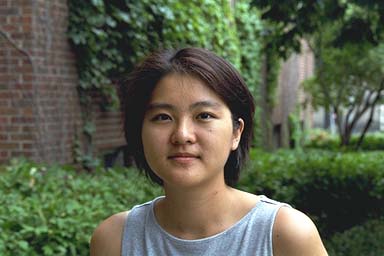
Home Institution: University of Minnesota, Twin Cities
Major/Minor:
MRSEC Mentor: Hillmyer
Preparation of Novel Biodegradable Polymer Blends
Despite its high modulus and tensile strength, polylactide (PLA), a biodegradable polymer, is intrinsically brittle. The strength of this interesting material can be improved by blending with tough polymers such as polyethylene (PE). However, as with most polymer blends, interfacial adhesion in PE/PLA binary blends is weak. Adding a small amount of polylactide-polyethylene block copolymer (PLA-b-PE) as a compatibilizer can reduce phase size and improve phase stability, adhesion and mechanical behavior of the composite material. Melt blending of binary and ternary blends will be conducted in the MiniMAX and Haake melt mixers to compare the effects of different blending conditions. The effect of high temperature annealing on particle size within the blends will be investigated using scanning electron microscopy (SEM) and laser scattering analysis techniques. The aim of this work is to determine the extent of homogeneity and phase stabilization of the blends upon addition of block copolymer. We expect that blends containing block copolymer should exhibit a greater degree of homogeneity of phases compared to binary blends, where a dispersion of fairly large PE particles within the PLA matrix is observed.
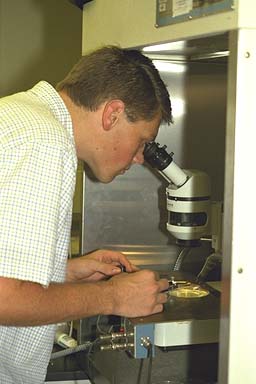
Home Institution: University of Minnesota, Twin Cities
Major/Minor:
MRSEC Mentor: Lodge
Metal contacts to Polyacene Organic Semiconducting Thin Films
Pentacene, Tetracene, and other polyacenes have shown great promise as organic semiconductors, with the possibility of reducing processing and manufacturing costs over traditional semiconductors. Thin films of these materials are deposited under vacuum onto an oxidized single crystal Si wafer using vapor phase deposition, and the films are characterized by Atomic Force Microscopy (AFM). Using metal evaporation under vacuum, metal contacts are patterned onto the thin film through a shadow mask. Device performance is directly related to what metal the contacts are patterned from. If the work function of the metal does not properly match the HOMO or LUMO bands of the semiconductor, the contact will be rectifying rather than ohmic. Contact area versus current is also of interest. Once the contacts have been deposited, the I-V characteristics of the devices are measured. From this data we can determine the usefulness of the metal in forming an ohmic contact, as well as the current density through the device.
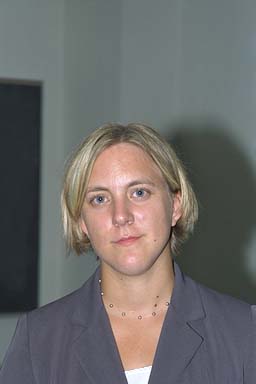
Home Institution: University of Wisconsin, Madison
Major/Minor:
MRSEC Mentor: Hillmyer
Effects of Glycation on Smooth Muscle Cells and Collagen Gels
The need for small diameter arterial grafts is increasing with the rise in heart disease. Several biologically engineered grafts have been produced, but many do not have the required mechanical strength to be used in the body. Recently, glycation has been used to increase the mechanical strength of media-equivalents. Glycation is induced by increasing the concentration of ribose in culture medium. As in diabetes, this causes the stiffening of soft tissues due to the nonenzymatic crosslinking of proteins. This study will further examine the effects incubation in ribose has upon the microstructure of collagen and smooth muscle cells, using histology and microstructure.

Home Institution: University of Wisconsin, River Falls
Major/Minor:
MRSEC Mentor: Lodge
Anomalous Micellization in Polystyrene-Polyisoprene Copolymer Solutions
The purpose of these experiments is to analyze the region of ∞8anomalous micellization∞± in polystyrene-polyisoprene copolymer solutions. Dynamic light scattering (DLS) will be implemented to analyze the solutions as a function of temperature. During DLS the scattered light intensity is measured. Using the intensity autocorrelation function and ultimately the Stokes-Einstein equation, the hydrodynamic radius (Rh) of the micelles will be found. It is hypothesized that anomalous micellization is due to trace amounts of homopolymer, which alter the micellization process. These homopolymers correspond to the first block in anionic polymerization, polystyrene in this case. Therefore, anomalous micellization is expected to occur in solvents which are polyisoprene (PI) selective, or in polystyrene (PS) selective solvents which have been doped with PI homopolymer. Once a solution exhibits anomalous micellization, the stability of the anomalous micellization will also be analyzed.
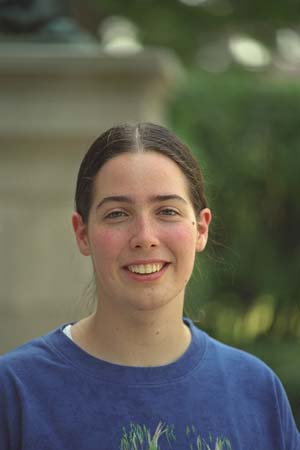
Home Institution: Gustavas Adolphus
Major/Minor:
MRSEC Mentor: Ward
Crystallization of organic polymorphs in polymer monoliths with adjustable porosity
Certain molecules have the ability to crystallize with more than one solid-state packing arrangement. Each of these arrangements, or polymorphs, exhibits different chemical and physical properties (e.g., solubility, color, and bioavailability) that affect their behavior and utility in, for example, the pharmaceutical, agricultural, and specialty chemical disciplines. Control of polymorphism, which is crucial to the synthesis and processing of crystalline materials, is typically difficult owing to the overcoming the capricious nature of polymorphism. Though there are isolated examples of polymorph control during crystallization, there does not exist a universal strategy overcoming the unpredictability of polymorphism. Our project aims to examine the influence of polymeric media on the crystallization of organic compounds and polymorphism.

Home Institution: University of Minnesota, Twin Cities
Major/Minor:
MRSEC Mentor: Tranquillo
The Effects of Intrinsic and Extrinsic Mechanical Stress on Upregulating Collagen Synthesis in tissue-Equivalents to Increase Mechanical Strength
Our lab group studies the production of tissue-equivalents (TE's) to replace diseased arteries, valves, etc. TE's are collagen constructs seeded with human cells. Their advantages are enhanced biocompatibility and the ability to grow, but currently have insufficient strength and stiffness to be used as a replacement tissue. One method to increase mechanical strength and stiffness is to upregulate collagen synthesis. To date, we have used fibrin gels to provide chemical cues to upregulate cell-mediated collagen synthesis (Neidert et. al. 2001). To further increase collagen production we plan on studying the application of intrinsic and extrinsic mechanical stresses. It is hypothesized that stiffer gels will cause intrinsic stresses on the cells and upregulate collagen synthesis. Intrinsic stresses will be increased by modulating the stiffness of the initial fibrin gel by cross-linking via Factor XIII or transglutaminase. Extrinsic stresses will be applied to fibrin gels at defined strains using a Flexcell Tissue Train system. The effectiveness of these protocols will be determined by assaying for total collagen content and by mechanical testing.

Home Institution: Centre College
Major/Minor:
MRSEC Mentor: Tranquillo
Prefailure and Failure Behavior of Inhomogeneous, Anisotropic Tissue Equivalents
The behavior of inhomogeneous, anisotropic tissue equivalents (TEs) under stress will be determined. The TEs are comprised of cells entrapped in a reconstituted type I collagen gel. Rat AT-1 and human dermal fibroblasts will be used independently to make the TEs. The alignment of the fibers in the TE will be manipulated by constraining the compaction of the fibers by the cells. The specific TEs to be studied will have inhomogeneous fiber alignment (i.e., the TE will have fiber orientations that differ from region to region). These tissues will be tested to determine their apparent stress versus strain relationship and fracture behavior when force is applied in varying directions. The data will be analyzed in connection with a computer simulation of TE micromechanics.
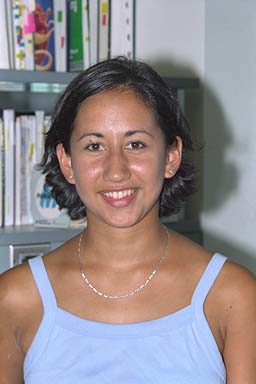
Home Institution: University of Minnesota, Twin Cities
Major/Minor:
MRSEC Mentor: Barocas
Characterization of Micro-fluidic Systems
Microscale chemical technology is evolving very quickly - with many potential uses in sight. We are developing and evaluating a 100-um-scale separator analyzer flow (SAF) meter to measures flow rates of macromolecular suspensions in micro-chemical systems. The SAF meter has two parts - a separator and an analyzer. The separator splits the mixture into two streams using electrophoresis to create different concentrations in each stream. The analyzer measures the concentrations using a capacitive technique. In theory, the concentration difference measured by the analyzer is inversely proportional to the flow rate in the separator. To test the separator, we will pump solutions of bovine serum albumin (BSA) through the SAF meter and measure the concentrations collected from each output via UV-vis spectrophotometry. To test the analyzer, we will analyze streams of known BSA concentration. Upon completion of this project, we will have thus assessed both major components of the SAF meter.

Home Institution: Cooper Union
Major/Minor:
MRSEC Mentor: Tranquillo
Substitution of Human Mesenchymal Stem Cellsin Place of Smooth Muscle Cells in an Artery Replacement
One focus of my graduate student mentor Jennifer Long and faculty advisor R.T. Tranquillo is on a tissue engineered artery replacement. Currently the components which make up the artificial artery are smooth muscle cells (SMC) grown in a compacted collagen or fibrin gel. The focus of this work involves the use of undifferentiated human mesenchymal stem cells (HMSC) derived from adult human bone marrow in collagen or fibrin gel hemispheres. One immediate benefit of HMSC over SMC is that stem cells can be harvested directly from the intended artery recipient; the recipient's immune system, therefore, will not reject the tissue. The goal of this study is to determine the feasibility of HMSC use in the tissue without loss of structural integrity and maintaining the immunological benefits. HMSC were treated with platelet derived growth factor (PDGF) in order to promote cell differentiation to smooth muscle cells or without growth factor to maintain the undifferentiated state. Cross sections of the hemispheres were made and stained with antibodies to reveal smooth muscle phenotype by noting the presence of actin and myosin, two cytoskeletal proteins necessary for gel compaction. Time course measurements of the gel hemisphere height were made to monitor compaction under the various culture conditions: initial cell concentration, presence of growth factor, gel type (collagen or fibrin). The results will enable an informed decision about using HMSC substitution in our artificial artery.
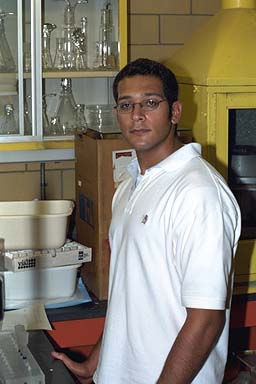
Home Institution: Bucknell University
Major/Minor:
MRSEC Mentor: Tranquillo
Oriented Chondroitin Sulfate Chains Influence On Proteoglycan Production In Chondrocytes
The hypothesis of the experiment is if chondroitin sulfate with correctly oriented CS chains will be more affective than randomly attached CS at stimulating PG production. Chondroitin sulfate on proteoglycans (PGs) increases the production of proteoglycans by chondrocytes. To construct artificial PGs, first chondroitin sulfate is isolated from bovine patella. The next part of the experiment is to use reductive amination to conjoin an amino group to the CS. With the amino group in place, the next step is to add a cross-linking molecule to the CS and BSA to form an artificial PG. Two cross-linkers are used, Sulfo-BSOCOES, which uses only the terminal amino to attach the ends of the CS to the BSA and carbodiimide, the control, which uses carboxyl groups at a number of different places on the CS to attach to the BSA. Finally, the artificial PGs are put in a chondrocyte culture that is deprived of extracellular matrix and tested how much the synthetic PGs will increase PG production.
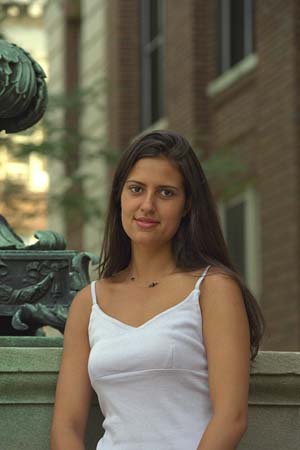
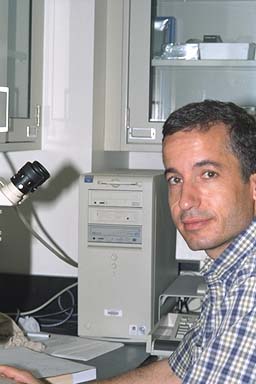
Home Institution: Penn State University
MRSEC Mentor: Ward
Synthesis and Characterization of Rigid and Chiral Mono- and Disulfonates for Crystal Engineering
The purpose of this research project is to synthesize a group of mono- and disulfonates with the general formula O3S - spacer - SO3. The spacer group will be designed in such a way that would allow us to control the rigidity, stereo-chemical, and sulfur-to-sulfur distance. These molecules will then be used to prepare host crystals with guanidinium salts. The resulting guanidinium sulfonates crystals will be used as hosts for organic guest molecules. The basic idea is to prepare polar host crystals capable of incorporating highly polar organic molecules to form asymmetric guest host crystals for use in second harmonic generation. Examples of target molecules include 4-stilbene sulfonic acid, and 4,4'-stilbene disulfonic acid. These molecules can be oxidized to produce chiral compounds, which will be used to prepare "chiral" crystals. Also, from chiral crystals, one can try to see if separation of racemic mixtures is possible. Other functional groups will also be explored; these include Bunte salts and phosphonates. Several other disulfonates will be synthesized with various spacer groups as well.
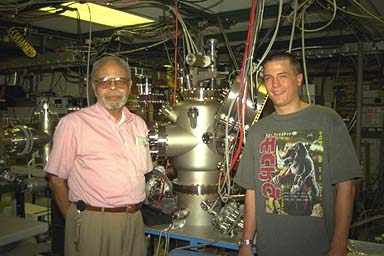
Home Institution: University of Louisiana Lafayette
MRSEC Mentor: Palmstrøm
Metal-Insulator-Metal Studies by In-Situ X-ray Photoelectron Spectroscopy
The work is focused toward understanding the evolution of the interfacial chemistry required for magnetic tunnel barrier junction process development, and is conducted in collaboration with a graduate student and a post doctoral fellow. Aluminum layers 4-10-20-30 Å thick are vacuum evaporated using effusion cells at a chamber pressure of ~ 7.5 x 10-11 Torr on Fe substrates (~ 150 Å thick, e-beam deposited, held at low but non-cryogenic temperatures). X-ray Photoelectron Spectroscopy (XPS) is employed to ensure the character and uniformity of the Al coverage, and its cleanliness. Sequential, and carefully controlled exposures of the Al layer to oxygen under UHV conditions occurred to establish the thickness of the chemically self-limiting insulating layers of Al2 O3 formed employing the XPS peak intensity ratio IAl 2 O 3 / IAl approach in conjunction with published values for the inelastic mean free path of the Al electrons photoemitted from the overlayer and substrate. In-depth analysis of the surface spectral features present after oxygen exposures also occurred. The identical overlayer-substrate approach using quantitative XPS determinations was applied in the follow-on deposition of a counter-electrode material, i.e., Al in this study, to establish its thickness. Thus, the interfacial chemistry of the Fe/Al/Al2O3/Al system was studied in some detail during Summer 2001. Low Energy Electron Diffraction (LEED) and Reflection High-Energy Electron Diffraction (RHEED) studies are planned. By variation, and precise control of the temperature of the Fe layer (e.g., from -10 °C to +25 °C, or cooling it to liquid-nitrogen temperature) for Al depositions on Fe, a variety of other interfacial barrier structures may be fabricated for spin polarization measurement and XPS data correlation comparison to advance process development. Further, still other barrier junctions may be fabricated by use of alternate metals as counter-electrode materials.

Home Institution: United Tribes
MRSEC Mentor: Stein
Assembly of Functional Porous Solids in Hybrid Materials
Three-dimensionally ordered macroporous (3DOM) metal oxides are prepared by filling the voids of polymer colloidal crystal template with a fluid precursor capable of solidification, followed by calcination to remove the template and simultaneously convert the precursor to a solid in the desired phase. Macroporous titania and zirconia materials prepared in this manner typically have nanocrystalline walls, in which small grains are fused together to form the 3 DOM skeleton. Control of the grain growth and interconnection will strengthen these materials, which is important for ease of processing and use in device applications. Synthesis conditions, including the choice of template, thermal treatment, synthesis atmosphere, and use of chemical additives will be varied to optimize the mechanical stability of the porous titania and zirconia materials. Nanoindentation measurements will be performed to evaluate the strength of the porous materials.
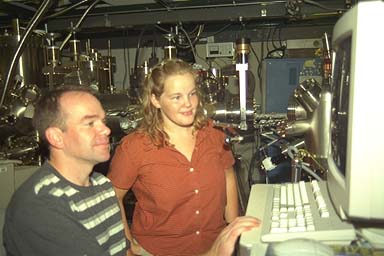
Home Institution: University of Wisconsin, Eau Claire
MRSEC Mentor: Palmstrøm
The Growth of ErAs(100) on GaAs(100) (2 x 4)-c(2 x 8) Annealed to 535 C Determined by Scanning Tunneling Microscopy
The scanning tunneling microscope (STM) will be used to study ErAs(100) and GaAs(100) (2 x 4)-c(2 x 8). Varying layers of ErAs will be grown on the GaAs substrate. By varying the surface reconstruction of the GaAs(100) from the 2 x 4 to the c(2 x 8) the initial growth of the ErAs layer on the GaAs(100) can be better understood. Previous STM studies of this surface has shown that ErAs deposited onto GaAs with a post deposition anneal ends up in a subsurface location. However, it is still unclear whether the ErAs has a tendency to burrow into the GaAs, or the GaAs percolates up to the surface. By using a combination of STM images and X-ray Photoelectron Spectroscopy (XPS) we hope to correlate the various surface reconstructions to the location of the Erbium and Gallium Arsenides when annealed to high temperatures.
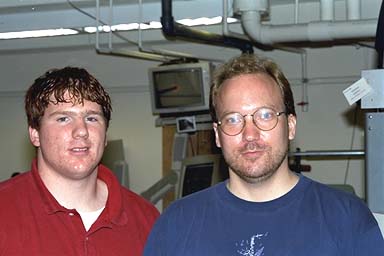
Home Institution: Augsburg College
MRSEC Mentor: Dahlberg
Setup of Magneto-Optical Kerr Effect System for the Study of Magnetic Coupling within Anti-ferromagnet - Ferromagnet Bi-layers
A Magneto-Optical Kerr Effect (MOKE) setup will be built to investigate exchange-coupled samples. MOKE is achieved by reflecting linearly polarized light off of a magnetic sample. The reflected beam passes through an analyzer into a detector. The use of an external magnetic field to change the magnetic characteristics of the sample results in the plane of polarization of the reflected light being rotated. Only a certain plane of polarization can pass through the analyzer, thus the rotation produces a change in detected intensity. A plot of this intensity versus the external magnetic field yields a hysteresis loop that is characteristic of the magnetic sample. The anti-ferromagnetic / ferromagnetic thin film samples that will be studied are NiMn / Co and NiO / NiFe. The samples will be produced using the sputtering method where a target is bombarded with Ar ions, depositing the sputtered material on a substrate.
UMN MRSEC
435 Amundson Hall, 421 Washington Ave. SE, Minneapolis, MN, 55455
P: 612-626-0713 | F: 612-626-7805